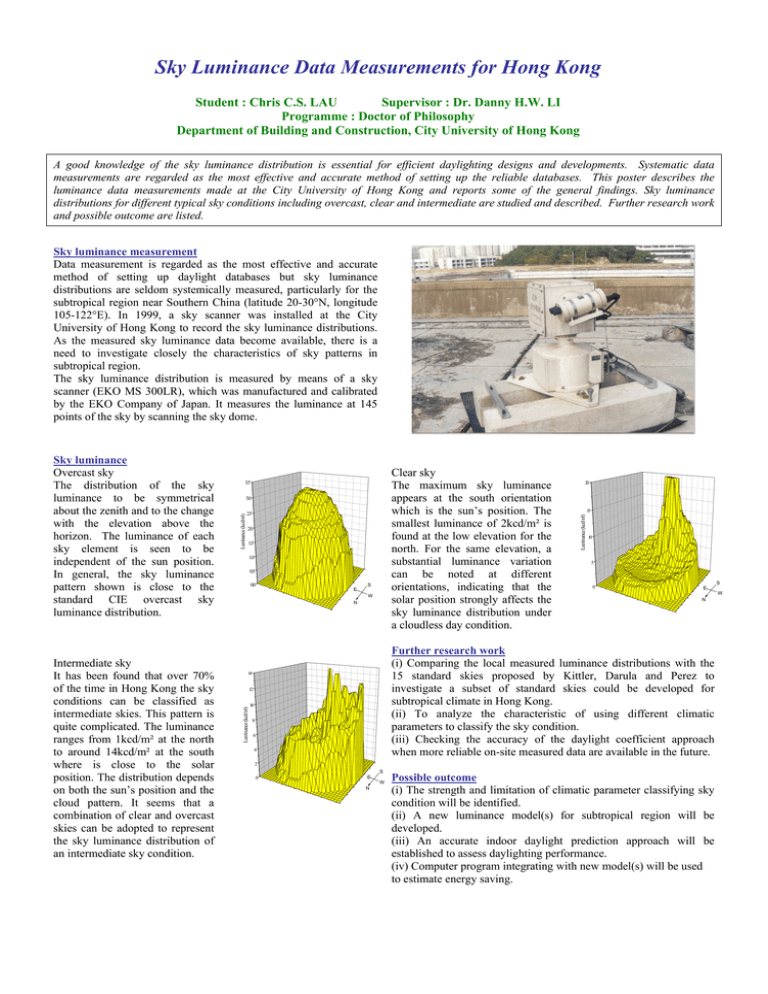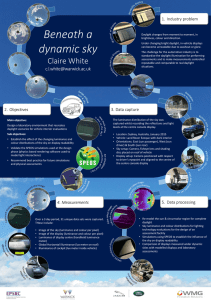Sky Luminance Data Measurements for Hong Kong
advertisement

Sky Luminance Data Measurements for Hong Kong Student : Chris C.S. LAU Supervisor : Dr. Danny H.W. LI Programme : Doctor of Philosophy Department of Building and Construction, City University of Hong Kong A good knowledge of the sky luminance distribution is essential for efficient daylighting designs and developments. Systematic data measurements are regarded as the most effective and accurate method of setting up the reliable databases. This poster describes the luminance data measurements made at the City University of Hong Kong and reports some of the general findings. Sky luminance distributions for different typical sky conditions including overcast, clear and intermediate are studied and described. Further research work and possible outcome are listed. Sky luminance measurement Data measurement is regarded as the most effective and accurate method of setting up daylight databases but sky luminance distributions are seldom systemically measured, particularly for the subtropical region near Southern China (latitude 20-30°N, longitude 105-122°E). In 1999, a sky scanner was installed at the City University of Hong Kong to record the sky luminance distributions. As the measured sky luminance data become available, there is a need to investigate closely the characteristics of sky patterns in subtropical region. The sky luminance distribution is measured by means of a sky scanner (EKO MS 300LR), which was manufactured and calibrated by the EKO Company of Japan. It measures the luminance at 145 points of the sky by scanning the sky dome. Intermediate sky It has been found that over 70% of the time in Hong Kong the sky conditions can be classified as intermediate skies. This pattern is quite complicated. The luminance ranges from 1kcd/m² at the north to around 14kcd/m² at the south where is close to the solar position. The distribution depends on both the sun’s position and the cloud pattern. It seems that a combination of clear and overcast skies can be adopted to represent the sky luminance distribution of an intermediate sky condition. Luminance (kcd/m²) 3.0 2.5 2.0 1.5 1.0 0.5 0.0 S E W N 20 15 Luminance (kcd/m²) Clear sky The maximum sky luminance appears at the south orientation which is the sun’s position. The smallest luminance of 2kcd/m² is found at the low elevation for the north. For the same elevation, a substantial luminance variation can be noted at different orientations, indicating that the solar position strongly affects the sky luminance distribution under a cloudless day condition. 3.5 10 5 0 S E W N Further research work (i) Comparing the local measured luminance distributions with the 15 standard skies proposed by Kittler, Darula and Perez to investigate a subset of standard skies could be developed for subtropical climate in Hong Kong. (ii) To analyze the characteristic of using different climatic parameters to classify the sky condition. (iii) Checking the accuracy of the daylight coefficient approach when more reliable on-site measured data are available in the future. 14 12 Luminance (kcd/m²) Sky luminance Overcast sky The distribution of the sky luminance to be symmetrical about the zenith and to the change with the elevation above the horizon. The luminance of each sky element is seen to be independent of the sun position. In general, the sky luminance pattern shown is close to the standard CIE overcast sky luminance distribution. 10 8 6 4 2 S 0 E W N Possible outcome (i) The strength and limitation of climatic parameter classifying sky condition will be identified. (ii) A new luminance model(s) for subtropical region will be developed. (iii) An accurate indoor daylight prediction approach will be established to assess daylighting performance. (iv) Computer program integrating with new model(s) will be used to estimate energy saving.

